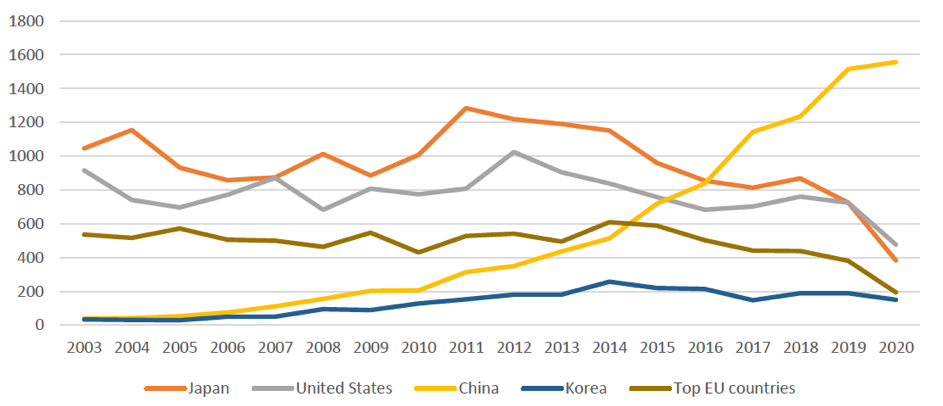By Antoine Le Gall (CERN)
An analysis of market-innovation trends of particle detectors stresses the decline in innovation growth of Europe in comparison to China.
The quest for discoveries in particle physics continuously drives available or emerging technologies beyond their limits, and the almost industrial scale at which this happens is one of the roots of its broader societal and economic impact. In the field of particle detector technologies, the role of industry is rapidly increasing due to the need of highly specialised equipment (for example in microelectronics integration), and due to the scale of the installations, where thousands or millions of components require industrial-scale production and quality control infrastructure.
Started in 2021, AIDAinnova strongly contributes to maintaining European leadership in the field of particle detectors by strengthening the links between academia and industry. Under the coordination of CERN, this Horizon 2020-funded project recently published a report to assess the innovation-market trends of particle detectors, both by technology and market applications. A combination of market research, patent landscaping and market survey, the document draws attention on the global state of R&D and market growth, highlighting the growth stalemate of Europe and the United States in comparison to China; and the need to build closer links between academia and industry to ensure European strategic sovereignty in semi-conductors.

Global particle detectors market, by geography (2021-2028)
(Source: Verified Market Research, VMR. (2020) Global Particle Detectors Market.)
The global particle detector market is currently estimated at USD 2.3 billion in 2020. On the rise, this market should grow by 60% by 2028. Traditional players are the United States, which holds the largest share (32%), followed by European markets led by the Germany (7%), the United Kingdom (4.7%), and France (4%), and Asian one (China: 7.7%; India: 4.7%; Japan: 3.1%). Innovation-wise, Japan, the USA and Europe currently occupy the top 3, although there are fewer and fewer patent applications being filed each year in these regions.
The status quo will soon be disrupted by China. Recent market data suggest that the Asian powerhouse is the fastest growing region for particle detectors. Also, since 2016, the country has been filling the most patent application for particle detectors, in sharp contrast with the global decrease. Based on this observation, the report expresses that “for Europe to remain relevant in the field of particle detectors, it is imperative it focuses on maximizing innovation in the technologies and the expertise.”

Number of patent applications under IPC Class G01T, per country of origin, by year.
(Source: Verified Market Research, VMR. (2020) Global Particle Detectors Market.)
Looking at technology trends, the market is currently dominated by gas ionisation (42%) and scintillation detectors (31%). Together with a patent landscape, this demonstrates the societal importance of innovation in particle detectors field, as a great part of the inventions in this space is aimed at contributing to applications in medicine (application in nuclear medicine, computerized tomography, etc.). In 2020, medical and healthcare accounted for the largest market share of 34%, with a market value of USD 800.23 million, followed by nuclear power plants and industrial applications, respectively around 20%.
